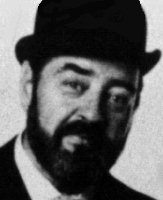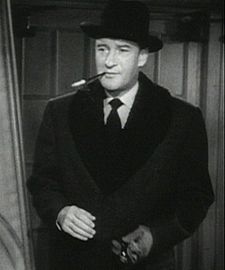The Jungle Book
Distributor: Buena Vista Distribution Co.
Studio: Walt Disney Productions
Director: Wolfgang Reitherman
Producer: Walt Disney
Original Release Date: October 18, 1967
 |
| Phil Harris, the voice of Baloo. |
 |
| Sebastian Cabot, the voice of Bagheera. |
Mowgli himself is a likable character (voiced by director Woolie Reitherman's son, Bruce Reitherman), he's not particularly a strong protagonist, but you can root for him. He is a little ignorant, but he's just a young boy who wants to live in the jungle. Bagheera is a very serious character. Sebastian Cabot was perfect, as he gives Bagheera an authority figure-esque attitude. ("You have the word of Bagheera!") He's not entirely humorless, though. At the end of the film, he becomes less stern and a little more loose as he happily sings "The Bare Necessities" with Baloo at the end.
King Louie steals the show. Originally, Disney wanted Louis Armstrong to do the voice. I can only imagine how that would've worked out, and what his song would've sounded like. Casting Armstrong ultimately didn't work out, thus they got Louis Prima to do the voice. A legend in big band, swing and jazz, Louis Prima was the perfect choice for this swinging, jazzy ape. Speaking of which, this would be the first animated film where the cast would be filled to the brim with celebrities. It wasn't the first time celebrities provided the voices in an animated film, as Disney cast Cliff Edwards (Ukelele Ike) as Jiminy Cricket in Pinocchio over 27 years prior to this film. The characters were also modeled after the celebrities who played them, which was new for an animated film at the time. Anyways, King Louie is an incredibly cool character. He wants to know the secret to man's fire, which he wants to get from Mowgli in the great song sequence, "I Wan'na Be Like You".
Then there's Colonel Hahti and his army of elephants. J. Pat O'Malley provided the voice for this character, as he has provided the voices for several other characters in past Disney films. He's a bumbling old elephant that forgets, contrary to elephants never forgetting. His wife (voiced by Verna Felton, another actress who has provided voices in several Disney animated films) keeps him in line, while his son (voiced by Clint Howard, Ron Howard's brother, and the voice of Roo in the first two Winnie the Pooh shorts) is adventurous and immediately befriends Mowgli.
 | ||
| George Sanders, the voice of Shere Khan. |
The other actors and actresses do a fine job. The vultures are voiced by Chad Stewart, Lord Tim Hudson, J. Pat O'Malley and Digby Wolfe. Chad Stewart was part of the British Invasion duo Chad & Jeremy (pictured on the left), Lord Tim Hudson was the producer for bands such as The Seeds and The Lollipop Shoppe. He also claimed to know The Beatles personally and had helped The Moody Blues get off the ground. He would later provide the voice of the Hip Cat in The Aristocats, the next animated feature. Digby Wolfe appeared in several famous TV shows at the time. John Abbot provides the voice of Akela the wolf, but the wolves aren't in the film for very long, but the actors did a fine job none-the-less. The voice of Spook and Brain from Hanna-Barbera's Top Cat, Leo D. Lyon, provided the voice of Flunkie, the baboon that rocks out with the big leaf during "I Wan'na Be Like You". Darleen Carr provides the voice of the girl from the man village, and she does a fine job. (I know she's called Shanti in the sequel, but the sequel shall not be acknowledged)
Aside from the characters, the songs are what also make the film work. Originally, the songs were written by Terry Gilkyson. His songs are radically different from the ones that the Sherman Brothers eventually wrote, but I'd say they're equal. Gilkyson's songs have a different feel altogether, since they were written when Bill Peet came up with his treatment of the classic story. The Sherman Brothers' songs reflect what Walt wanted, a fun, upbeat comedy. Thus the songs are fun and upbeat, and they certainly work.
Of course the only song from the original treatment that made it into the final film was "The Bare Neccesities", as the Sherman Brothers' version is different from Gilkyson's version. The Sherman Brothers' version is a classic, and one that is probably drilled into everyone's heads. "I Wan'na Be Like You"? That's a wonderful song, and certainly the wildest one in the film. It's a real show-stopper. "Trust in Me" is a lazy, laid-back song that sounds almost like a hallucination. Well, Kaa's eyes in hypnotize mode are trippy anyway. It was added to the film later on during production since test audiences liked Kaa. Hathi's march song, simply called "Col. Hathi's March", is also catchy. The final song, "My Own Home", is beautiful and it's a nice finale to the film's collection of upbeat songs. It complements the film's bittersweet ending. Adding to the brilliant songs is George Bruns' wonderful score, which captures the mood of the Indian jungle setting. It's very calm and tranquil, but still conventional and inviting.
Let's take a look at the songs that didn't make it. In order to hear these songs, you have to pop in disc one of the Platinum Edition DVD. They're all demos, so who knows what the final versions would've sounded like. "Brothers All" was meant to be the opening to the film, a rather dreary song with very ominous vocals. "The Song of the Seeonee" was going to be sung by the wolves, so I assume the wolves were more important in Bill Peet's treatment of the story. It's another eerie song, but it is interesting nonetheless.
The original version of "The Bare Necessities" isn't as upbeat as the Sherman Brothers' version, but it certainly doesn't pale in comparison. The rather poppy, silly-sounding "Monkey See, Monkey Do" was going to be the apes' song. Mowgli was to sing a nice ballad called "I Knew I Belonged To Her", and judging by the demo recording, he was supposed to grow up in this earlier version of the film. "In a Day's Work" was apparently a song that was to be sung by the folks in the man village. Last but not least was "The Mighty Hunters", Shere Khan's song, a pretty dark song at that and the perfect villain song for this character. This song is also sung by a scrapped character named Buldeo. Buldeo was a manipulative hunter from the man village who wanted Mowgli to take him to the treasure located under the palace at the bandar-log where the monkeys lived. It's too bad that this subplot had to go.
 |
| Buldeo the Hunter, from Peet's original treatment. |
In the next part, we'll take a look at Bill Peet's original treatment of the story, the animation and the film's legacy.



No comments:
Post a Comment